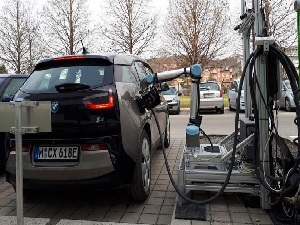



Date:16/08/18
 In order to make electric cars more appealing to consumers, automakers have been experimenting with robotic chargers that automatically plug themselves into specific cars such as Volkswagens or Teslas. A new system, however, is designed to work with a wide variety of electric vehicles.
In order to make electric cars more appealing to consumers, automakers have been experimenting with robotic chargers that automatically plug themselves into specific cars such as Volkswagens or Teslas. A new system, however, is designed to work with a wide variety of electric vehicles.
The system is part of the KoMoT project (Komfortable Mobilität mittels Technologieintegration, or "convenient mobility by means of technology integration"). It was developed by a team at Austria's Graz University of Technology, working with colleagues from BMW, MAGNA Steyr Engineering, the KEBA automation company, and the Austrian Society of Automotive Engineers.
Installed at an indoor or outdoor charging station, the setup incorporates several cameras that image vehicles as they pull up and park at that station. The cars do not have to be parked in a precise spot, and the system works under various lighting conditions.
By analyzing the images from the cameras, the high-capacity charger is able to identify the make/model of car, plus it can locate the vehicle's charging port and identify what type it is. It then extends a liquid-cooled charging plug of the appropriate type, and sticks it in. In some cases, a charge can reportedly be completed within a matter of minutes.
"For the first time we have found a way to automatically recharge several vehicles, one after another, using a robotic charging station, without the need to adapt the vehicles," says Bernhard Walzel, who is overseeing the research.
Robotic system identifies EVs and charges them up
 In order to make electric cars more appealing to consumers, automakers have been experimenting with robotic chargers that automatically plug themselves into specific cars such as Volkswagens or Teslas. A new system, however, is designed to work with a wide variety of electric vehicles.
In order to make electric cars more appealing to consumers, automakers have been experimenting with robotic chargers that automatically plug themselves into specific cars such as Volkswagens or Teslas. A new system, however, is designed to work with a wide variety of electric vehicles.The system is part of the KoMoT project (Komfortable Mobilität mittels Technologieintegration, or "convenient mobility by means of technology integration"). It was developed by a team at Austria's Graz University of Technology, working with colleagues from BMW, MAGNA Steyr Engineering, the KEBA automation company, and the Austrian Society of Automotive Engineers.
Installed at an indoor or outdoor charging station, the setup incorporates several cameras that image vehicles as they pull up and park at that station. The cars do not have to be parked in a precise spot, and the system works under various lighting conditions.
By analyzing the images from the cameras, the high-capacity charger is able to identify the make/model of car, plus it can locate the vehicle's charging port and identify what type it is. It then extends a liquid-cooled charging plug of the appropriate type, and sticks it in. In some cases, a charge can reportedly be completed within a matter of minutes.
"For the first time we have found a way to automatically recharge several vehicles, one after another, using a robotic charging station, without the need to adapt the vehicles," says Bernhard Walzel, who is overseeing the research.
Views: 691
©ictnews.az. All rights reserved.Similar news
- The mobile sector continues its lead
- Facebook counted 600 million active users
- Cell phone testing laboratory is planned to be built in Azerbaijan
- Tablets and riders outfitted quickly with 3G/4G modems
- The number of digital TV channels will double to 24 units
- Tax proposal in China gets massive online feedback
- Malaysia to implement biometric system at all entry points
- Korea to build Green Technology Centre
- Cisco Poised to Help China Keep an Eye on Its Citizens
- 3G speed in Azerbaijan is higher than in UK
- Government of Canada Announces Investment in Green Innovation for Canada
- Electric cars in Azerbaijan
- Dominican Republic Govt Issues Cashless Benefits
- Spain raises €1.65bn from spectrum auction
- Camden Council boosts mobile security





















